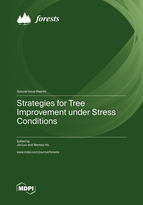Strategies for Tree Improvement under Stress Conditions
A special issue of Forests (ISSN 1999-4907). This special issue belongs to the section "Forest Ecology and Management".
Deadline for manuscript submissions: closed (19 April 2023) | Viewed by 28906
Special Issue Editors
Interests: nitrogen use efficiency; transcriptome; woody plant; abiotic stress
Special Issues, Collections and Topics in MDPI journals
Interests: mycorrhizal symbiosis; forest tree stress biology; mycorrhizal fungal fruiting body cultivation
Special Issues, Collections and Topics in MDPI journals
Special Issue Information
Dear Colleagues,
Perennial woody plants usually are faced with multifactorial adverse conditions during their long lifespan, which impairs their growth and productivity. To cope with these adverse conditions, trees deploy morphological, physiological, and molecular responses to adapt to the environmental constraints. By using high-throughput sequencing and bioinformatic approaches, many hub genes involved in stress responses were identified. In recent years, with the advantages of transgenic technology in woody plants, many candidate genes participating in stress responses were functionally characterized and showed great potential for tree improvement under different stresses. On the other hand, cultivation strategies (including beneficial microorganism investigation, beneficial microorganism inoculation, mixed forest, and so on) also play crucial roles in tree improvement under abiotic and biotic stress.
This Special Issue focuses on the strategies for tree improvement under stress conditions; all original research findings and perspectives relative to tree improvement in coping with environmental constraints are welcomed.
Dr. Jie Luo
Dr. Wentao Hu
Guest Editors
Manuscript Submission Information
Manuscripts should be submitted online at www.mdpi.com by registering and logging in to this website. Once you are registered, click here to go to the submission form. Manuscripts can be submitted until the deadline. All submissions that pass pre-check are peer-reviewed. Accepted papers will be published continuously in the journal (as soon as accepted) and will be listed together on the special issue website. Research articles, review articles as well as short communications are invited. For planned papers, a title and short abstract (about 100 words) can be sent to the Editorial Office for announcement on this website.
Submitted manuscripts should not have been published previously, nor be under consideration for publication elsewhere (except conference proceedings papers). All manuscripts are thoroughly refereed through a single-blind peer-review process. A guide for authors and other relevant information for submission of manuscripts is available on the Instructions for Authors page. Forests is an international peer-reviewed open access monthly journal published by MDPI.
Please visit the Instructions for Authors page before submitting a manuscript. The Article Processing Charge (APC) for publication in this open access journal is 2600 CHF (Swiss Francs). Submitted papers should be well formatted and use good English. Authors may use MDPI's English editing service prior to publication or during author revisions.
Keywords
- forest tree
- bioinformation
- gene expression
- cultivation strategy
- transgenic technology
- beneficial microorganism
- stress






